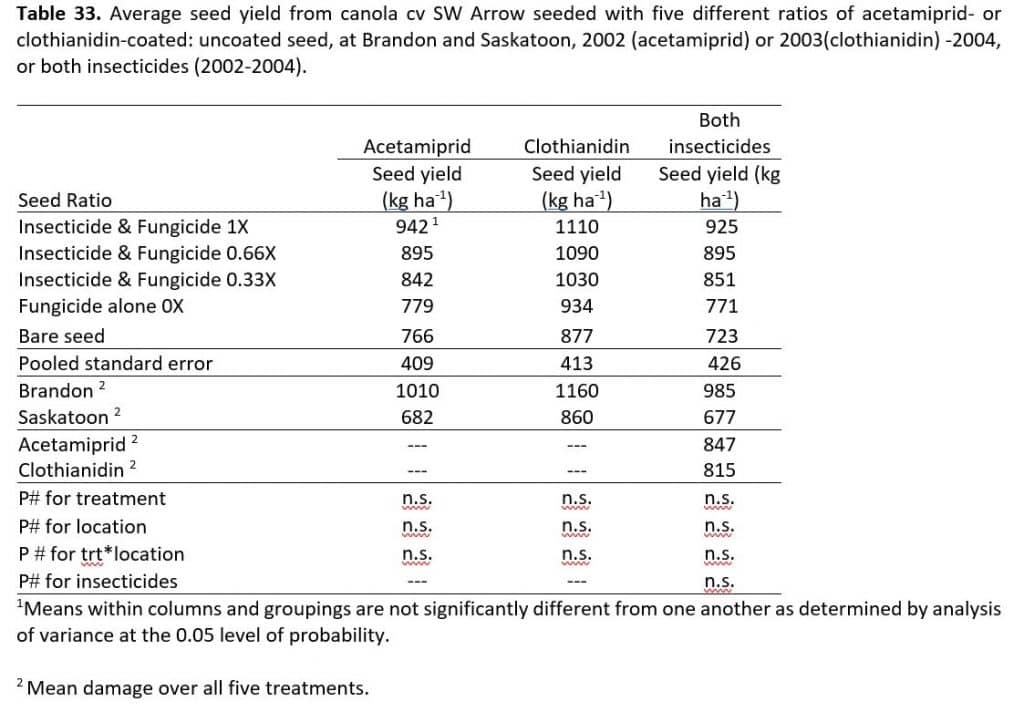Key Result
The project demonstrated that treating two of every three seeds with insecticides kept feeding by flea beetles at levels equivalent to that of all seeds treated. When feeding pressure was not extreme, seed yields were not compromised by the reduction in insecticide application. Under extremely heavy flea beetle feeding pressures, additional insecticides need to be applied no matter what the initial application ratio.
Project Summary
The project consisted of activities to control flea beetles in canola while reducing insecticide levels in the process. The main investigation, conducted at Brandon and Saskatoon, examined the effects of decreased proportions of seed treated with insecticide on control of flea beetle damage to canola seedlings. Two reduced proportions of treated seed, consisting of 2/3 and 1/3 of the seed treated with insecticide, were compared to all seeds treated, and with fungicide alone and bare seed controls. The insecticide acetamiprid (Premium Plus®, Assail®) was evaluated at both locations from 2002 to 2004, and at Melita, MB, in 2003. The insecticide clothianidin (Prosper 200®) was evaluated in 2003 and 2004 at Brandon and Saskatoon. There were 32 feeding damage ratings and 11 site years of seed yield data. The insecticides were examined in separate trials, as the main purpose of the experiment was to examine differences among levels of treated seed, not differences between seed treatments.
Flea beetle feeding pressure was especially high in 2002 and 2003, when drought was a factor in beetle feeding and canola growth. Flea beetle feeding damage to seedlings in the 0.66X treatment was similar to that of 1X treatment seedlings in 20 of the 32 damage evaluations. The 1X treatment had significantly lower feeding damage than did the other treatments on only two evaluation dates, and in 10 evaluations, mostly the last evaluation of the year, when insecticide effects were wearing off, all damage ratings were similar among all treatments. Plant stand and seedling growth rates were generally similar between 1X and 0.66 X treatments. The 0.33X treatment tended to have flea beetle feeding levels between those of the two high and the two no insecticide treatments.
Seed yield differences were not as great as they may have been because feeding levels often were greater than economic thresholds in all treatments. In five of the 11 site years, the 0.66X treatment had seed yields similar to the 1X treatment, both of whose yields were greater than the insecticide-free treatments. In five instances, there were no differences in seed yields among treatments. And in only one site year the 1X seed treatment had significantly greater seed yields than any other treatment.
In practical terms, whether the decrease in monetary and environmental costs of utilizing decreased proportions of insecticide-coated seed offsets the increased time and handling necessary to mix untreated and treated seed lots is a decision best left to the individual producer. In more and more instances untreated seed is no longer available to the producer, and the question of proportions is irrelevant. However, when flea beetle feeding levels are not severe, utilizing a partial rather than full proportion of insecticide-coated seed may prove monetarily and environmentally advantageous. In cases of severe flea beetle feeding, as was seen in 2003, supplemental application of foliar insecticides is likely necessary no matter what proportion of coated to uncoated seed is used.
In secondary investigations, five commercial canola fields, three in Manitoba and two in Alberta, were utilized in investigations testing the feasibility of using border rows only of insecticide to control flea beetle damage to the entire crop. While some interesting results were found, no uniform trends could be discerned in optimum distance of insecticide border, or even in efficacy of the border at all. In an investigation in 2004 at Brandon and Saskatoon, herbicide-intolerant seed was mixed with herbicide-tolerant seed in an effort to diffuse flea beetle feeding by increasing seeding rates of canola, and so minimize damage to individual seedlings. Results were not definitive, and the idea was not disproved.






